In ‘Ice Cream’, a DirecTV spot directed by Rupert Sanders, two battling cyborgs literally crash and burn through several rooms of an apartment as the owner manages to pause their actions. We talk to MPC in Los Angeles about their visual effects work for the commercial, with some great before and after clips.
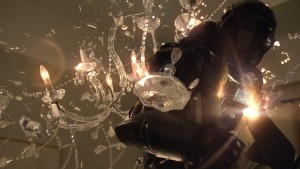 fxg: I actually got a phone call from a friend who saw this spot during the World Series, which I think was the first time it aired, telling me I had to watch it, and I think he was right. Can you tell me what was your initial brief was?
fxg: I actually got a phone call from a friend who saw this spot during the World Series, which I think was the first time it aired, telling me I had to watch it, and I think he was right. Can you tell me what was your initial brief was?
Andrew Bell (VFX producer): We always knew we only had four weeks to complete the project. The script initially was supposed to be two people fighting like in The Bourne Identity. But the director, Rupert Sanders, took it to the next level and thought it would work really well as two robots or cyborgs, just to give it a futuristic and sci-fi feel. Legacy Effects did a great job of building the in-camera suits and it was Rupert’s idea to build this relief detail on the suit in camera, so that in the faster and more action-packed shots that would have been enough. Rupert then took it to another level and didn’t want it to look like people in robotic suits, so the idea was for the limbs of those robots to not look human. That moved things more into the post world than we had anticipated.
Frank Lambertz (co-VFX supe and lead 2D): Rupert is a very clever man. He understood what could be done in such a short time and was a great collaborator with Legacy Effects and MPC.
Bell: The bottom line was that we had 46 arm and leg replacement shots to do for the robots, which was a big undertaking.
fxg: What was involved in creating the 3D and making sure you could matchmove everything?
Mike Wynd (VFX supe and lead 3D): We didn’t really know until we got into it, but every scene was camera-tracked first and everything set to a consistent scale and then it was a matter of matchmoving frame by frame.
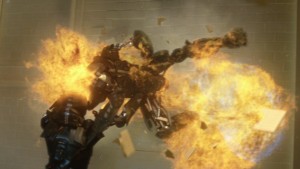 Lambertz: We did in the end add a few tracking markers on things like the shoulders as the shoot went on, just to help us. And, oh, there was so much motion blur.
Lambertz: We did in the end add a few tracking markers on things like the shoulders as the shoot went on, just to help us. And, oh, there was so much motion blur.
Wynd: The motion blur was both a help and a hindrance. It made it very, very difficult to track the characters and there was a lot of guesswork and toing and froing between 2D and 3D. It was hard to see where things were sitting without the motion blur on, and yet the motion blur also hid a lot of problem shots.
Lambertz: What was clever in the way that the suit was designed was that all the junctions, say for the shoulders and knees, were visible in-camera.
Bell: Yeah, that let us have key shoulder joints, with a ball joint, ready for us to insert the 3D.
Wynd: As part of their build of the suit, the Legacy guys actually built a 3D model. So we could take that and have a fully rigged complete character. That helped in matchmoving and getting everything in the right dimensions.
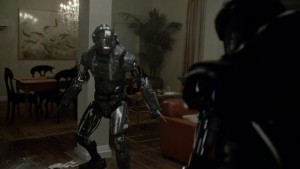 fxg: What were some of the key tools you guys were using?
fxg: What were some of the key tools you guys were using?
Wynd: The 3D was all done in Maya and most of the tracking was Maya Live.
Lambertz: In commercials, we are using a lot of MPC’s film pipeline as well so there were a bunch of proprietary tools.
Bell: From my point of view as a producer, the cleverest thing that we did was for the 3D replacement where we really had to fill in the gaps behind the suit. Everything had been shot hand-held so there wasn’t a clean plate of the background. So the guys took endless amounts of stills of the set and made the set as proxy geometry in 3D, and then projected those stills onto that geometry to help restore the background.
Lambertz: Yeah, easy!
Wynd: There was obviously a lot of work in that. We were also able to get a model of the set from the set designers which was very detailed, but it was nowhere near the right dimensions.
Lambertz: Because it was a big matchmoving job and we had all the camera data from the 3D work, we could use that as a starting point, but there was still a lot of painting frame by frame.
fxg: What was the compositing workflow?
Lambertz: The 3D comp for the battle was done in Nuke, and then after that all the shots went through Flame. For the pause shots, the fire shot was done in Flame and the chandelier in Nuke. So the overall workflow was: matchmoving in 3D, creating 3D arms and legs, 2D cleaning to re-create the backgrounds and then compositing.
fxg: Let’s talk about the pause shots – how was the fire frozen moment created?
Lambertz: The fire shot was interesting. We had to join two hand-held camera shots. We didn’t want to go with a motion control move because the brief really was to keep it hand-held. The first shot was just throwing these guys against the wall and seeing what would happen. After we had a plate that we liked, we then tried to match it by shooting a new shot of him against greenscreen.
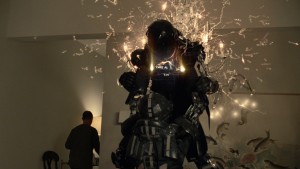 Wynd: So when the guy gets thrown against the wall, that’s one camera move. Then while he’s up against the wall and our hero guy walks through the shot, that’s another distinct camera move shot at a different time of day. Marrying those two camera moves together seamlessly was very interesting. We ended up doing a full 3D handover of the robot at that point.
Wynd: So when the guy gets thrown against the wall, that’s one camera move. Then while he’s up against the wall and our hero guy walks through the shot, that’s another distinct camera move shot at a different time of day. Marrying those two camera moves together seamlessly was very interesting. We ended up doing a full 3D handover of the robot at that point.
Lambertz: It was an interesting way to work between 2D and 3D because Mike did his join using Maya for 3D and boujou to track. Then using Flame I could project the information from Maya and use a bunch of 2D tweaks to join the plates together. Some elements were from the first camera move and some from the other.
Wynd: It was actually really good to be throwing the cameras and geometry backwards and forwards between Flame and 3D. If we tried to do it all in 3D, it would have taken so long, and being able to get almost instant feedback meant that we were able to fix things very quickly.
fxg: How was the actual fire generated?
Wynd: This was done in Maya Fluids. For that second shot where the guy walks through, it allowed us to add some real elements to augment the 3D. I think the realism of this comes from the fact that for the frozen moments, the basis of them really is just holding the two actors in place and moving the camera around.
Bell: And that poor guy was in a lot of pain just being held there by a wire and a harness and cable coming off his back. He had to be let down at one stage.
fxg: Then there’s the chandelier shot. Can you take me through that?
Lambertz: This was a challenging shot because we could not really control what was going on with all the pieces of glass. We were not that keen to do a full-3D chandelier. So when they shot it, they wired the guy and rigged the chandelier to explode.
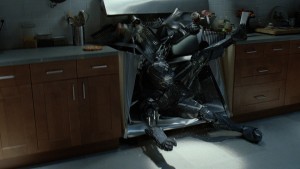 Wynd: To hold the guy in place, he was strung from above and then strung down onto the floor as well. He wasn’t going anywhere! They basically had him in an upside down Y-shaped harness.
Wynd: To hold the guy in place, he was strung from above and then strung down onto the floor as well. He wasn’t going anywhere! They basically had him in an upside down Y-shaped harness.
Lambertz: It was shot in one take and as the chandelier exploded the DOP had two cameras panning around to create the camera movement in the three shots that we see in the commercial. It’s pretty simple but it worked so well.
Wynd: Considering we had a chandelier all wired up and as soon as you touched one bit of it, the whole thing floated all over the place.
Lambertz: The explosion is all in-camera for the frozen moment, although we added some 2D sparks and things floating around the guy were in 3D. Then we were able to use our 3D camera in Nuke to create that 3D volume appearance.
Credit List
Client: DirecTV
Spot: Ice Cream
Director: Rupert Sanders
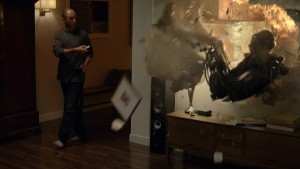 Agency: Grey New York
Agency: Grey New York
Agency Producer: Andrew Chinich
EVP Chief Creative Officer: Tor Myhren
SVP Creative Director: Denise O’Bleness
SVP Account Director: Alison Monk
VP Account Director: Tamar Arslanian
Production Company: MJZ
Production Company Location: LA
Director: Rupert Sanders
Production Company Producer: Laurie Boccaccio
Executive Producer: Eric Stern
DOP: Greig Fraser
Editorial Company: Work/Spotwelders
Editor: Neil Smith
Post Production Company: MPC
Post Production Company Location: Los Angeles
VFX Producer: Andrew Bell
VFX Supervisor(s): Franck Lambertz & Mike Wynd
Flame Artist: Franck Lambertz
Support: Brendan Smith, Saron Marcussen, Brinton Jaecks, Ryan Knowles, Ben Persons, Adam Frazier, Kim Stevenson
3D: Mike Wynd, Ross Denner, Daniel Marsh, Fred Durrand, Ian Wilson, Danny Wynne, John Cherniack, Maru Ocantos
Telecine Company: MPC LA
Colorist: Mark Gethin
